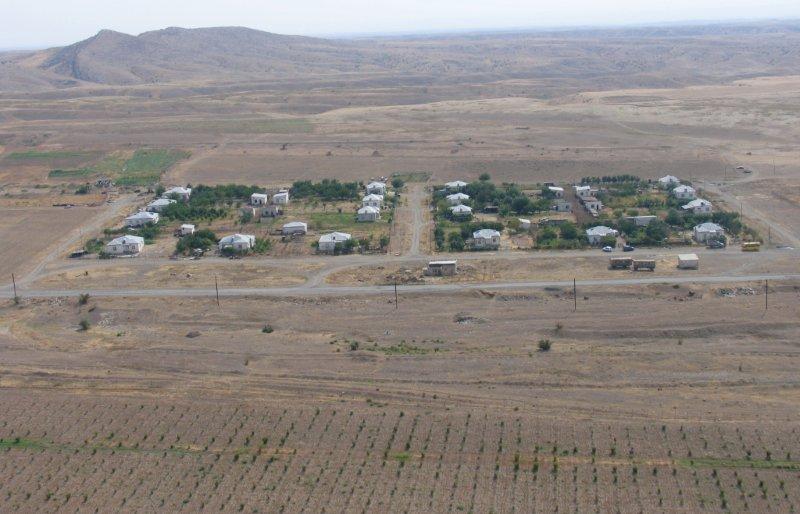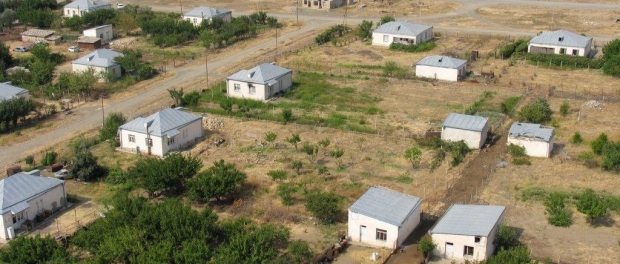The Hairenik Weekly and Armenian Weekly recently spoke to Antranig Kasbarian, former executive director of the Tufenkian Foundation and a member of the Artsakh Fund Committee, about the Arajamugh Village Project, a collaboration between the Tufenkian Foundation and the Artsakh Fund of the Eastern United States for the development and expansion of Arajamugh village in Artsakh (Nagorno-Karabagh Republic/NKR). In this interview, Kasbarian provides background about this project, which has taken on a greater sense of urgency following the four-day war in April. The goal of the project is to expand the Arajamugh village to include 50 homes, complete with a kindergarten and a cultural center to serve as a model village.

Arajamugh Village from a distance
Over the past 20 years, Kasbarian has been a lecturer, activist, and community leader; he has worked regularly as a journalist, activist, and researcher in Artsakh. A former Central Committee member of the Armenian Revolutionary Federation – Eastern U.S., and former editor of the Armenian Weekly, he holds a Ph.D. in geography from Rutgers University. His doctoral dissertation dealt with the geography of nationalism during the 1988-1994 war in Nagorno-Karabagh, based largely on his own experiences on the ground. He has published widely on the region in both academic journals and the press.
***
Armenian Weekly—For years, Armenian communities in the United States have worked to support Artsakh. Could you briefly discuss these efforts?
Antranig Kasbarian—As early as 1988, our U.S. communities have provided important assistance to Artsakh. Such assistance has come in many forms—medical, logistical, infrastructure, and much more—stretching from the early phases of self-determination struggle (1988-1990), to the phase of all-out war (1991-1994), to post-war reconstruction, and of course during the present crisis as well. Many groups and individuals, from all corners of our community, have played a role in this effort. This includes, of course, the role played by the Armenian Revolutionary Federation (ARF) and its affiliates, most prominently the Armenian Relief Society (ARS).
With the passing of time, community efforts have gradually moved from emergency relief to more long-term developmental assistance. In this regard, the most prominent effort was likely the Goris-Lachin-Stepanakert highway—the so-called “Bridge of Life”—which effectively took Artsakh out of its isolated state and created direct ties with Armenia. That project was spearheaded by the Hayastan All-Armenia Fund, and enjoyed the support of nearly every organized Armenian group worldwide. More recently, given the recent»hostilities, there has been a move back toward direct, short-term aid, which is wholly understandable.
A.W.—What is the focus of these efforts, particularly after the “four-day war” in April?
A.K.—In the aftermath of the “Four-Day War,” there was an immediate outpouring of assistance—funds for fallen and wounded soldiers and their families, medicines and other supplies, equipment needed for defense, as well as numerous volunteers who went to Artsakh as fighters or in a supporting role. Among these early efforts, the most vigorous was to help the families of those affected. While private efforts will not replace the NKR government’s obligations towards these people, it was an encouraging show of support. The people of Artsakh truly felt our solidarity.

Arajamugh Village
Now, as the dust settles somewhat, there are emerging efforts that are slightly different: longer-term reconstruction and resettlement efforts focused on fortifying Artsakh’s border regions; efforts to coordinate various assistance programs, in order to reduce duplications of activity; and efforts to bolster our national defense, both operationally and at the level of resources. Most of these efforts involve public and private partnerships; i.e. they cannot be done by any one organization alone, but usually require a pooling of efforts, especially with local governmental authorities. The governments of Armenia and Artsakh are also conducting internal reviews, as they should, in order to shore up any weak spots revealed by the recent hostilities.
A.W.—Please discuss the Arajamugh Village project.
A.K.—The Arajamugh Village is found in southern Artsakh, roughly 40 km beneath Hadrut, in territories liberated by Artsakh defense forces in late 1993. In terms of organized resettlement, it represents the southernmost presence of civilian population in Artsakh. As such, it is an important outpost—one lying not far from the southeastern front recently subject to invasion of Azerbaijani forces.
The village project was initiated in 2004 by the Tufenkian Foundation, working in conjunction with the NKR Department of Refugees and Resettlement. The village today features 19 houses and associated infrastructure, a school and town hall, a nearby pomegranate orchard, as well as nearly 90 inhabitants, including a mix of retired officers, former refugees from Azerbaijan, and young families from nearby, surrounding areas. In 2012, following a working visit to Artsakh, the Armenian Cultural Azzociation of America (ACAA) Artsakh Fund decided to assume responsibility for expanding the village, developing its infrastructure and livelihood opportunities, and working with existing/future resettlers. This year, we are building six homes and associated infrastructure for the village. Our project manager is Raffi Killian of Chicago, who is collaborating with the Tufenkian Foundation on a transitional basis, gaining hands-on experience as we prepare to assume responsibility moving forward. We also consult periodically with the NKR government as well as the ARF organization in Artsakh, sharing views/approaches on tactics and strategies pertaining to resettlement.
If all goes well, this first phase of activity will conclude in October. We’ll then evaluate the results, and decide on future directions of activity.
A.W.—Please discuss the efforts in the Eastern region of the U.S. towards this end.
A.K.—»We have an active, well-rounded committee, consisting of the following individuals: Myself, Hovsep Avakian, John Avedissian, Sebouh Hatsakordzian, Raffi Killian, Michael Mensoian, Alex Sarafian, and Garo Tashian representing the Armenian Youth Federation (AYF). Speaking of the AYF, their summer interns are hoping to spend a week in July with us, serving in work brigades during summer construction. We expect this will be a great learning experience for our youth, as it can foster positive interaction, above and beyond the actual construction work.
Our committee meets regularly, discussing the village expansion project as well as associated efforts on behalf of Artsakh. We conduct periodic fundraising and awareness events, which have sustained the activities up until this time. These efforts will receive an additional boost in the coming weeks, as our communities
will host Lernik Hovhannisyan, a prominent ARF parliamentarian representing the Kashatagh (formerly Lachin) district.
Unger Lernik is very well-informed about Artsakh’s strategic border regions, and will discuss these in light of the recent Four-Day War. We expect his presence to help our efforts considerably, not least by educating the community. If I’m not mistaken, he will visit around seven communities in a two-week span.
A.W.—What are some of the challenges, and how is the committee addressing them?
A.K.—In a project of this sort, there will always be obstacles and pitfalls for while we’re accustomed to donating for projects abroad, it is a different thing to
manage»a project abroad, with boots on the ground, ensuring completion of all deliverables in a timely and effective manner. This is a new but important step for us, in that we’ll eventually become more closely integrated into the fabric of life in Artsakh, and in a strategic border-zone, no less. Of course, there is much we must learn through this process—local customs, best practices in construction and economic development—but if we remain engaged and committed, the fruits of our labor will become visible for all to see. I am hopeful.
The Hairenik Weekly and Armenian Weekly recently spoke to Antranig Kasbarian, former executive director of the Tufenkian Foundation and a member of the Artsakh Fund Committee, about the Arajamugh Village Project, a collaboration between the Tufenkian Foundation and the Artsakh Fund of the Eastern United States for the development and expansion of Arajamugh village in Artsakh (Nagorno-Karabagh Republic/NKR). In this interview, Kasbarian provides background about this project, which has taken on a greater sense of urgency following the four-day war in April. The goal of the project is to expand the Arajamugh village to include 50 homes, complete with a kindergarten and a cultural center to serve as a model village. Arajamugh Village from a distance Over the past 20 years, Kasbarian has been a lecturer, activist, and community leader; he has worked regularly as a journalist, activist, and researcher in Artsakh. A former Central Committee member of the Armenian Revolutionary Federation – Eastern U.S., and former editor of the Armenian Weekly, he holds a Ph.D. in geography from Rutgers University. His doctoral dissertation dealt with the geography of nationalism during the 1988-1994 war in Nagorno-Karabagh, based largely on his own experiences on the ground. He has published widely on [...]
The Hairenik Weekly and Armenian Weekly recently spoke to Antranig Kasbarian, former executive director of the Tufenkian Foundation and a member of the Artsakh Fund Committee, about the Arajamugh Village Project, a collaboration between the Tufenkian Foundation and the Artsakh Fund of the Eastern United States for the development and expansion of Arajamugh village in Artsakh (Nagorno-Karabagh Republic/NKR). In this interview, Kasbarian provides background about this project, which has taken on a greater sense of urgency following the four-day war in April. The goal of the project is to expand the Arajamugh village to include 50 homes, complete with a kindergarten and a cultural center to serve as a model village. Arajamugh Village from a distance Over the past 20 years, Kasbarian has been a lecturer, activist, and community leader; he has worked regularly as a journalist, activist, and researcher in Artsakh. A former Central Committee member of the Armenian Revolutionary Federation – Eastern U.S., and former editor of the Armenian Weekly, he holds a Ph.D. in geography from Rutgers University. His doctoral dissertation dealt with the geography of nationalism during the 1988-1994 war in Nagorno-Karabagh, based largely on his own experiences on the ground. He has published widely on [...]
[img][/img]
More...